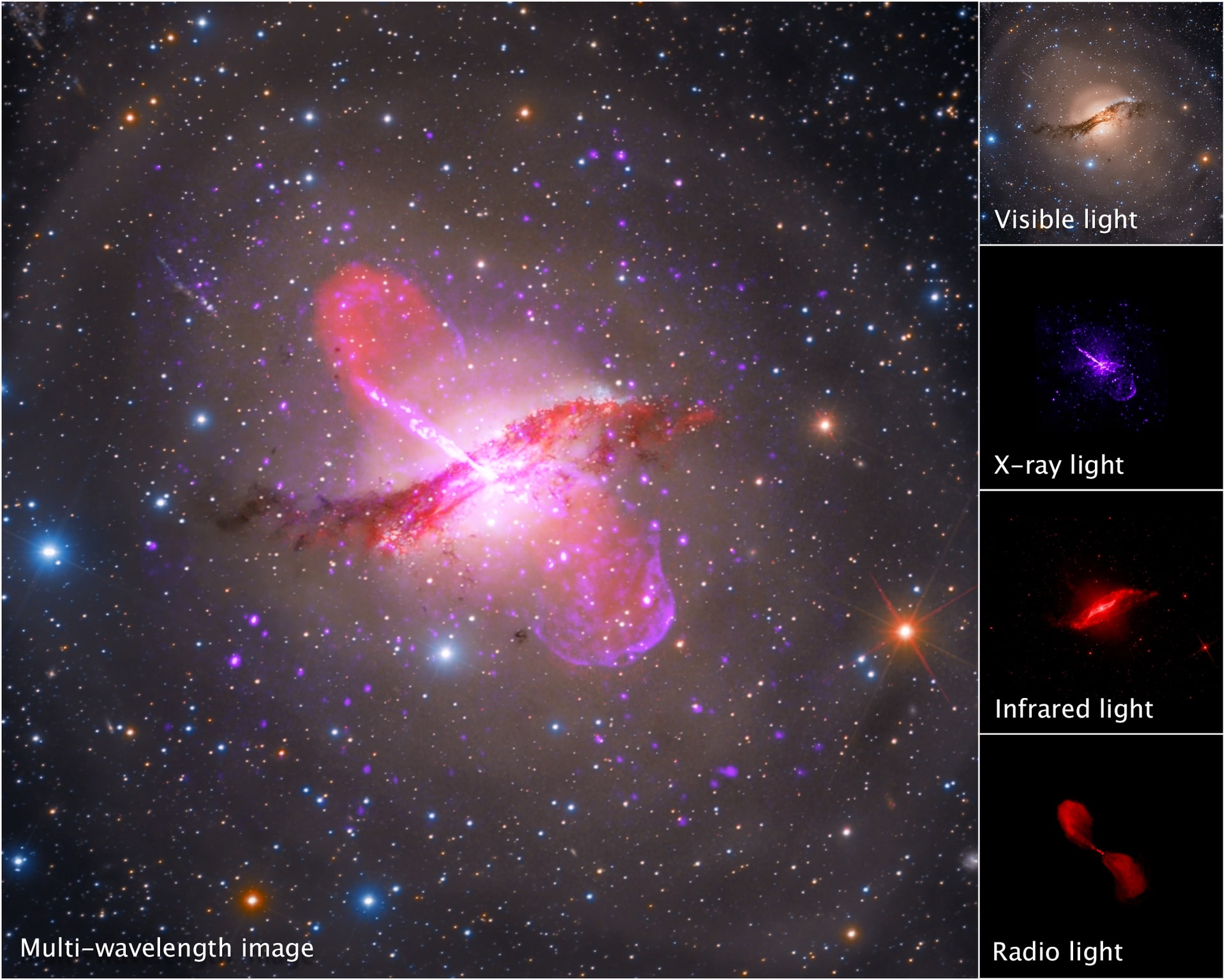
A radio galaxy is a galaxy that dominates the sky over Earth in radiowaves. These intense radio emissions originate from vast lobes of gas that extend well beyond the galaxy's visible structure, often spanning millions of light-years.
Typically appearing in pairs, these radio lobes form when the galaxy's core contains an active galactic nucleus (AGN). This extremely luminous region is powered by a supermassive black hole, superheating and feeding on the surrounding material, causing the galaxy to radiate brightly.
Related: How galaxies form: Theories, variants and growth
Around 15% to 20% of galaxies with AGNs are bright in radiowaves and are classed as being "radio loud," according to the California Institute of Technology (Caltech). Quite what makes one AGN "radio loud" and another "radio quiet" is not currently fully understood, as the emissions of other wavelengths of light from ultraviolet to X-rays are similar from both types of AGNs.
Some research suggests radio loudness may be connected to host galaxy type, with radio galaxies almost exclusively taking the form of giant elliptical galaxies. These galaxies could be created by the merger of two smaller galaxies. Radio emissions could also be connected to the rotation of the central black hole, which may facilitate the formation of powerful jets.
Radio Galaxy FAQs
What are examples of radio galaxies?
Famous examples of radio galaxies include Cygnus A, with a bright radio source that consists of two bright lobes of billowing gas and dust on either side of a galactic nucleus, Messier 87, with twin jets extending from a bright nucleus, and Centaurus A, an elliptical galaxy intersected by a lane of dust.
What are the two types of radio galaxies?
There are two distinct types of radio galaxies defined by differences in their optical emissions. Broad-line radio galaxies show broad-line light emissions from ionized oxygen, hydrogen, and silicon in their optical spectrum. Narrow-line radio galaxies are AGNs that lack broad-line emissions but have narrow emission lines from hydrogen and triplely-ionized oxygen.
What is the difference between a radio galaxy and a normal galaxy?
A radio galaxy is a galaxy that possesses an active galactic nucleus (AGN) pushing out lobes that emit bright radiowaves. Many galaxies like ours don't have AGNs, which are powered by feeding supermassive black holes, but even those that do are not necessarily blasting out radiowaves or "radio loud." It is only these AGNs that are defined as radio galaxies.
What fuels "radio loud" active galactic nuclei?

The most commonly held model of radio galaxies suggests that the massive dual radio lobes get their energy from the jets of supermassive black holes. As the jets feed the lobes, the pressure within them builds, and they billow outwards.
The most common radio galaxy structures are double near symmetrical elliptical lobes extending for many thousands of light years from the AGN to up ten times the width of the Milky Way, comprising the largest single structures astronomers have ever seen. These clouds of plasma — superheated ionized gas — are aligned with the center of their galaxies and can also take the form of elongated plumes in less bright radio galaxies.
Some radio galaxies, like Messier 87, located 55 million light years from Earth, have visible jets emerging from their AGN going directly into the galaxy's plasma plumes, supporting this growth mechanism.
Some radio galaxies possess a second pair of smaller lobes located closer to the AGN. These are believed to have been ejected by a similar but more recent event to that which launched the first pair of lobes, meaning the smaller lobes haven't had time to expand.
Radio wave emissions from these lobes are derived from so-called synchrotron radiation generated by electrons in the lobes being accelerated to relativistic speeds — velocities approaching that of light in a vacuum — by powerful magnetic fields. The synchrotron radiation isn't just seen in radio waves, if the electrons are accelerated to high enough speeds, emissions are also seen in infrared, optical, ultraviolet light, and even in X-ray radiation.
The radio wave emissions of radio lobes can be so powerful they can give off as much energy per second as ten times the total energy emitted by the entire Milky Way galaxy, according to the operators of the Large Sky Area Multi-Object Fibre Spectroscopic Telescope (LAMOST).
What was the first radio galaxy discovered, and who discovered it?
The discovery of radio galaxies occurred in the late 1930s and early 1940s when radar operators during the Second World War accidentally started to pick them up. It would take another ten years to better understand what had been discovered as the practice of radio astronomy burgeoned.
The first radio galaxy ever detected was Cygnus A, discovered by one of the pioneers of radio astronomy, Grote Reber, in 1939, a featureless oval elliptical galaxy of the same name located around 500 million light-years away, according to Britannica. It remains one of the closest and brightest radio galaxies ever discovered.
Cygnus A consists of two characteristic lobes emerging from a compact galactic nucleus. On the right, a jet is emerging from this nucleus that is feeding energy to the right lobe. Present but less conscious is a second jet to the left of the nucleus supplying energy to the left lobe. [M. H. Jones., et al., 2015]. These jets are emerging from a supermassive black hole at the heart of Cygnus A, which is thought to have a mass equivalent to 2.5 billion suns.
Radio stars! Famous examples of radio galaxies
Cygnus A is one of the most prominent examples of a radio galaxy, but other exceptional radio-loud supermassive black hole-powered galaxies exist in the universe.
Centaurus A, also known as Caldwell 77 or NGC 5128, is located around 12 million light-years from Earth, making it one of the closest radio galaxies to us and the fifth brightest galaxy in the sky over Earth. One extraordinary feature of this radio galaxy is the thick lane of dust that runs through it, obscuring its AGN heart. This is thought to be the result of a merger with another galaxy with Centaurus A about 500 million years ago.
The supermassive black hole at the heart of Centaurus A is considered to have a mass around 100 million times that of the sun. The radio lobes of Centaurus A can be seen extending out for 1.6 million light-years, with a smaller secondary set of lobes within them that stretch for around a tenth of this distance, about 160,000 light-years.
Not only is M87, also known as Virgo A, a radio galaxy, but it is also home to one of the most famous black holes in the history of astronomy. The supermassive black hole in M87, which has a mass around 4,5 billion times that of the sun, isn't just launching jets that power the radio emissions of this galaxy, it is also the first black hole ever imaged in humanity, seen by the Event Horizon Telescope in 2017 and released to the public in 2019. The radio lobes of M87 billow out for an estimated 130,000 light years.
Located in the Perseus cluster, the radio galaxy NGC 1265 is known as a "head-tail radio galaxy" because its lobes stretch out behind it, almost as if they are being swept back by a tremendous cosmic wind. The cause of this is theorized to be magnetic polarization in the tail.
Radio galaxy expert Q&A
Why do astrophysicists like yourself think giant radio galaxies might be the product of galaxy mergers?
'Radio galaxies' tends to be the term given to galaxies with large jets coming from their centers but the crucial additional element in understanding their connection to mergers involves what's called their excitation level. If the radio galaxy is a high excitation radio galaxy, it is shining brightly in ways that are independent of the jet and this might be due to a recent merger. There are low excitation radio galaxies too, which, on the other hand, are likely very old galaxies where relatively little material is falling into the black hole and no merger signatures are visible. These objects were likely triggered by mergers but looked very different at that time and have evolved over characteristic timescales of billions of years to become these low-excitation objects with jets. M87 is a classic example.
If radio galaxies are the product of mergers, does this mean there were fewer radio galaxies in the past? How might astrophysicists look for evidence for this model of radio galaxy evolution?
Again, we need to distinguish between the high and the low excitation radio galaxies. The high excitation radio galaxies experienced a peak in the past, a few billion years ago while the low excitation radio galaxies appear to dominate at later times. This suggests an evolution of one type of radio galaxy into another. My work has explored this evolution in terms of black hole spin, with high spin counter-rotating black holes triggered in mergers and a natural time evolution leading to the low excitation radio galaxies at late times with intermediate spin co-rotating black holes. The evidence for a redshift dependence of radio galaxy type is quite good and is the result of multiwavelength observations across the entire electromagnetic spectrum.
What do astrophysicists think causes the massive jetted AGNs in radio galaxies?
The general agreement is that magnetic fields are responsible for this. Many think black hole spin is also a key ingredient but there is much confusion. Much of my work has been to show how to understand the connection between jets and black hole spin. The key takeaway point is that in addition to magnetic fields and high or low black hole spin, counter-rotation/co-rotation between black hole and accretion disk is fundamental.
What can we learn about the evolution of galaxies in general from studying radio galaxies?
If you study one particular subclass of active galaxy, you are likely to remain confused, because you cannot take what you learn and generalize it to understand the accreting black hole phenomenon in general. I have recently shown that one needs to take a global approach that considers the type of active galaxy (radio galaxies are one type), the rate of star formation, the so-called velocity dispersion of stars in the galactic bulge, the excitation level of the galaxy, the type of environment (dense or isolated), the black hole mass, and the density of stars in the nucleus of the galaxy. When you consider all this, you can understand the feeding and feedback of black holes across space and time.
Additional resources
The "action" of radio galaxies is defined by the activity of the supermassive black holes embedded within them. This NASA animation shows the vast scale difference between the smallest and largest known examples of these cosmic titans. Collisions between galaxies could be responsible for creating the mass elliptic galaxies that mostly account for radio galaxies. A simulation from the Hubble Space Telescope shows how such a collision would be expected to proceed.
Bibliography
Radio Galaxies, Open University, [Accessed 1/10/23], [https://www.open.edu/openlearn/science-maths-technology/introduction-active-galaxies/content-section-3.4]
M. H. Jones., R. J. A. Lambourne., S. Serjeant., An Introduction to Galaxies and Cosmology, Cambridge University Press, (2015), ISBN: 978 1 107 49261 5
S. Serjeant., Observational Cosmology, Cambridge University Press, (2010), ISBN: 978 0 521 15715 5
U. Kolb., Extreme Environment Astrophysics, Cambridge University Press, (2010), ISBN: 978 0 521 18785 5
C.L. Carilli., P.D. Barthel., Cygnus A, The Astronomy and Astrophysics Review, (1996), [https://link.springer.com/article/10.1007/s001590050001]
OBSERVED PROPERTIES AND EMPIRICAL CLASSIFICATION OF AGN, CalTech, [Accessed 1/10/23], [https://ned.ipac.caltech.edu/level5/Urry1/UrryP2.html]
V. L. Ginzburg., et al., The Origin of Cosmic Rays, (1964), [https://www.sciencedirect.com/topics/physics-and-astronomy/radio-galaxies]







